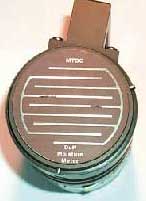Duff
Moisture
Meter
Moisture
Meter
Rocky Mountain Research Station
Forestry Sciences Laboratory - Moscow, Idaho
| Engineering Home | DMM Home | How it Works | Comments from the Field | Publications | Photo Gallery |
|
|
Duff
Moisture Meter |
USDA Forest Service Rocky Mountain Research Station Forestry Sciences Laboratory - Moscow, Idaho |
|||||
|
|||||||
| Principles of Operation | |

The DMM600 Duff Moisture Meter is held open showing the sample chamber and the compression plate. The output display window is shown in the inset photograph (upper left corner). |

Electrodes in the meter. |
|
Water content measurements depend on the dielectric properties of the duff material.
Water has a permittivity value greater than other duff constituents by more
than an order of magnitude, which makes this measurement sensitive to
the water content of the duff in contact with the sensor electrodes.
When the sample chamber is empty, with air acting as the dielectric surrounding
the sensor electrodes, the output frequency is approximately 42 MHz.
With duff material in the sample chamber serving as the dielectric, the output frequency decreases according to the water content of the duff sample. Air voids in organic material can reduce the apparent dielectric constant by creating inconsistent contact with the electrodes. However, using the duff moisture meter's compression feature on sieved material ensures that each sample is pressed evenly against the electrodes, which reduces measurement variability. |
|
| Calibration | |
|
The output frequency is converted to a volumetric water
content using a calibration derived from curve fitting laboratory and
field data.
The accuracy of the duff moisture meter is ±1.5 percent at 30 percent volumetric water content and ±4 percent at 60 percent volumetric water content. The response of the DMM600 to changing moisture content is best described with a quadratic calibration equation: Volumetric Water Content = 5.288 + 5.905 * freq - 0.412 * freq 2 where freq is the DMM600 output display frequency in MHz. |
|

The error bars on the standard calibration curve for the DMM600 duff moisture meter show that variations are smallest for lower volumetric water contents (after DMM600 Instruction Manual, 2002, Campbell Scientific, Inc., Logan, Utah). |
|
|
Gravimetric and Volumetric Water Content … What's the Difference?
|
|
|
The DMM600 standard calibration output gives the water content measurement results in volumetric terms (VWC).
Most fire managers and fire behavior modeling programs, such as
FOFEM and
FARSITE,
use gravimetric water content (GWC) to describe duff moisture content.
The DMM 600 can display two output values—one will always be the VWC based on the standard calibration and the second value is chosen by the user. Most fire managers choose to program the GWC as the second value. This is easy to do and can be set up within the duff moisture meter prior to going to the field. How the DMM600 Works (222K PDF file)
|
|
| < DMM home | Comments from the field > |